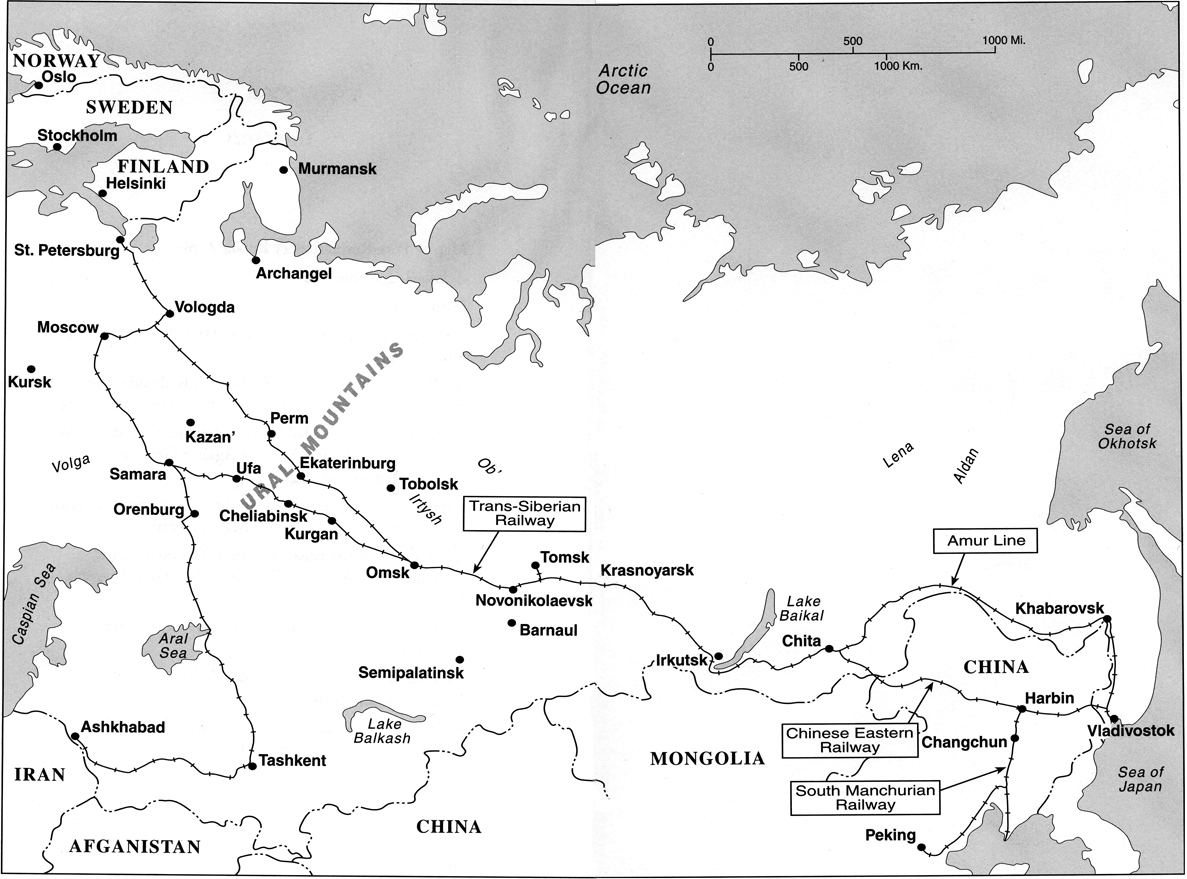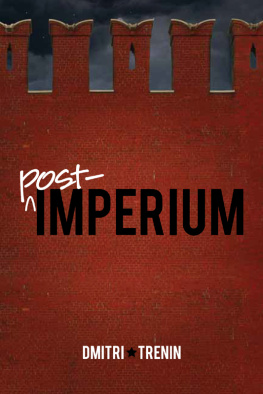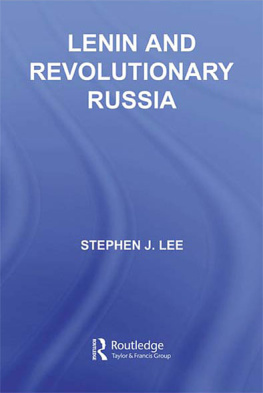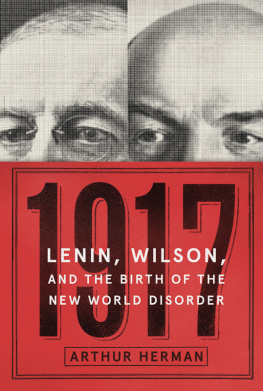
Reconstructing Russia
RECONSTRUCTING

| RUSSIA U.S. Policy
in Revolutionary
Russia,
19171922 Leo J. Bacino The Kent State University Press Kent, Ohio, and London |
1999 by the Kent State University Press, Kent, Ohio 44242
All rights reserved
Library of Congress Catalog Card Number 9921764
ISBN 0-87338-635-3
Manufactured in the United States of America
06 05 04 03 02 01 00 99 5 4 3 2 1
Library of Congress Cataloging-in-Publication Data
Bacino, Leo J., 1959
Reconstructing Russia: U.S. policy in revolutionary Russia, 19171922 / Leo J. Bacino.
p. cm.
Includes bibliographical references and index.
ISBN 0-87338-635-3 (cloth : alk. paper)
1. Economic assistance, AmericanRussia (Federation)Russian Far EastHistory20th century. 2. Russian Far East (Russia)RelationsUnited StatesHistory20th century. 3. United StatesRelationsRussia (Federation)Russian Far EastHistory20th century. I. Title.
HC340.12.Z7F2723 1999
British Library Cataloging-in-Publication data are available.
for my father

Contents
The Open Door, Wilsonianism, and the New
Frontier in Siberia


Over the years I have benefited enormously from the faculty and students of the Department of History at Northern Illinois University. I owe a tremendous debt to the NIU history faculty for a rich and diversified intellectual training; they are a credit to public education. Most importantly, I want to thank my director, Carl P. Parrini. He embodies the highest personal and intellectual qualities of a teacher-scholar. I also want to acknowledge my theoretical debt to Mary O. Furner and to thank her for her participation on my dissertation committee. From my earliest undergraduate courses, teachers like William Beik, C. H. and Margaret George, and Marvin Rosen provided direction and inspiration. Since this study is a revised version of my Ph.D. dissertation, I would also like to thank the other members of my committee, W. Bruce Lincoln and Anthony Scaperlanda, for their careful reading of my dissertation and the help they provided in the final stages of the dissertation process.
I have been very fortunate to have been associated with an exceptional group of students at NIU. I will always value the friendship and support I have received from this close-knit group. In particular, I want to acknowledge Bill Burr, Thomas Elkins, Brian Forberg, Linn Freiwald (who very generously took the time to edit the manuscript), Keith Haynes, Michael Hickey, Jean Kadel, Jim Livingston, Larry Lynn, Sandy Mazzola, Bruce Nelson, Sonia Nelson, Don Rodrick, Richard Schneirov, Paul Street, and Robert Tyree.
I have benefited gready from my discussions with historians David Foglesong, Linda Killen, and Thomas Knock, whose research has enriched our understanding of Wilsonian foreign policy.
The editors and readers at The Kent State University Press have been exceptionally helpful and gracious throughout the process. I especially want to thank director John Hubbell and managing editor Joanna Hildebrand Craig for their assistance and assistant editor Erin Holman, who conscientiously guided the manuscript through the copyediting process at Kent State. Clarence Wunderlin and Mary Ann Heiss deserve special thanks for introducing me to this fine press.
For technical assistance I would like to thank Dennis Butzow, Ilga Janouskovec, and Joel Leer.
My research has been facilitated by the assistance of many generous archivists at the National Archives, the Library of Congress, Yale University, the International Harvester Archives, the Wisconsin State Historical Society, the Hoover Institute and Stanford University Libraries, and the manuscript department of the Regenstein Library at the University of Chicago. The staff at the Northern Illinois University library, particularly the interlibrary loan and government publications departments, have facilitated my research over many years.
Finally, I thank my mother, Elizabeth Bacino; my family, Dennis and Elizabeth Butzow; and Dr. William Cohen for all of their support.

The American intervention in Siberia during the Russian Revolution and civil war left no lasting effects on the region, other than a legacy of bitterness and mistrust for future Soviet-American relations. But seventy years of Soviet-American rivalry has obscured the fact that, during the Russian Revolution and civil war, Siberia had been a focal point in the United Statess struggle against the rival powers to recast the international economic and political order. This forgotten dimension of the American intervention in Russia represented a sophisticated foreign assistance program. It now deserves careful reevaluation in view of the important lessons it can provide for contemporary American policymakers who are struggling to devise effective policies for post-Soviet Russia.
In 1918, the decisive year of the calamitous world war, American statesmen were deeply concerned that the Russian Empire would be divided into German and Japanese spheres of influence. The origins of World War I itself lay in the rivalry over spheres of influence in semidependent developing regions, such as China, Eastern Europe, and the Middle East. The collapse of the Provisional Government in Russia at the end of 1917 intensified this rivalry among the remaining powers by transforming the Russian Empire itself into an arena in this global struggle between imperial systems. During the extraordinary years 1918 and 1919, when a political vacuum existed in the empire, Germany, Japan, Britain, and France all pursued policies in Russia that were aimed at establishing spheres of influence of one form or another. If these powers had been allowed to dismember the Russian Empire, this would have given added impetus to their ongoing struggle to divide the remaining developing regions. This possibility alone required the United States to become actively involved in Siberia as part of its larger effort to promote the Open Door.
In contrast to this framework of great-power rivalry, American statesmen viewed bolshevism as epiphenomenal, a symptom of the czarist regimes pervasive social and economic malaise that the war had unleashed. Indeed, during 1918 much of the Wilson administrations antagonism toward the Bolsheviks arose from the practical consideration that this revolutionary regime served as a pawn in the larger systemic conflict among the Great Powers.
At the threshold of a new historical epoch, American statesmen also perceived tremendous opportunities for Russian-American relations. The Wilson administration had greeted the March Revolution of 1917 in Russia as an event that could have a great impact on the postwar international order. With the establishment of the Provisional Government, the administration was encouraged that Russia would now begin to evolve a constitutional form of government. As a corollary to this social and political process, major American corporate groups believed a post-czarist Russia would welcome American investment as an alternative to the politically based pattern of European investment during the czarist years. In this event, Russia would be disposed to participate in the international economy on terms consistent with Open Door principles: a world system that operated under rules that guaranteed equality of opportunity for trade and investmentin direct contrast to the existing system of preferential spheres of influence.
Next page













